Category: Hunting Tactics
M.R.I. – Scouting for Deer using Most Recent Information
It’s the time of year when my scouting for the upcoming season reaches a frenzied state. Scouting is simply an effort by the hunter to significantly increase his/her odds of observing and or harvesting the gender and age class deer of their choice. My mission is to harvest mature (4 year old or older) bucks. These bucks typically have a smaller core area and are extremely difficult to hunt without alerting them to your presence.
I’m constantly looking at Reconyx images, thinking about buck patterns I’ve learned about while managing the property during past years, etc. It’s critical to understand how bucks use the food, cover, and water resources available within their core area. Certainly some mature bucks will make trips outside their core area, but these trips can’t be predicted, and therefore can’t be counted on for the hunter to be successful.
Observations and data from past years are important in understanding how deer generally use a property. However, to place a stand so that mature bucks will walk within 40 yards requires M.R.I. – Most Recent Information.
The horrific drought that is currently ongoing in many states provides the perfect illustration for the value of M.R.I. Obviously sources of water that have been available in the past may not exist this fall. In some areas there may have been so many sources of water that bucks weren’t using any source of water regularly enough to establish a detectable pattern. That may not be the case this year and sources of water may provide the best option to pattern mature bucks.
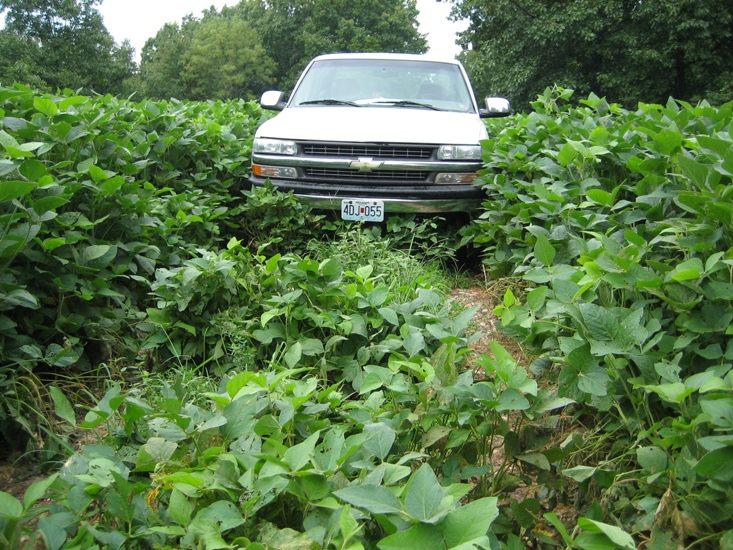
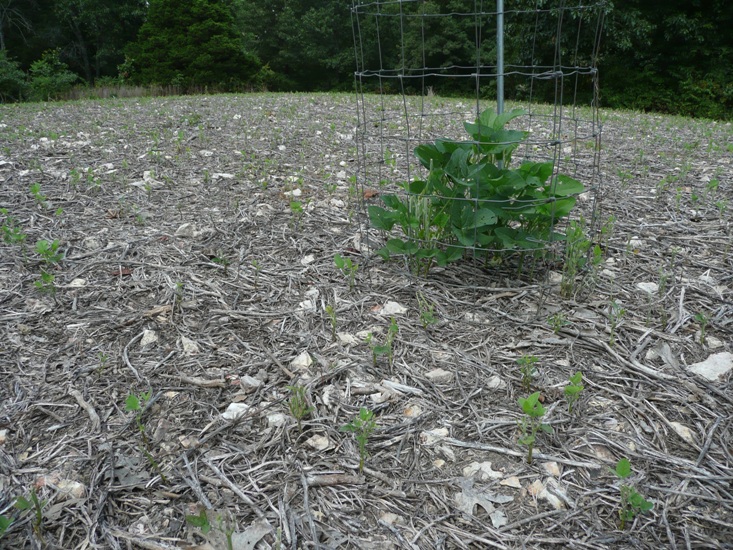
Food is another factor that may have very limited distribution in areas impacted by the drought. The images above are from the same food plot, taken during the same time of year. The local deer density didn’t increase that much from one year to the next. However, the growing conditions changed significantly! Growing conditions were average to slightly better than average during 2010. It was the 4th driest and the hottest July on record at the same location during 2011. Certainly deer feeding patterns will change from 2010 and 2011. Stand locations that were productive during 2010 may be a biological desert during 2011.
However, using M.R.I. to scout, 2011 may be a better hunting year. Finding the limited food and water resources may make for some fantastic stand locations!
By definition, M.R.I. changes rapidly. Don’t count on data from last year to place your stands this year. If you do, you might be watching a biological desert.
Growing (and hunting) Deer together,
Grant
Locating Deer Blinds
I was in Kentucky the past couple of days working on a property that a client is purchasing. The property has the potential to produce quality deer. However, producing and harvesting are two different tasks. To do both on a sustained basis requires planning and skill. The property has multiple openings that my client will use for food plots. Even though we are currently spraying, fertilizing, and planting these plots, it’s also time to think about hunting them. It’s only mid June, but it’s time to position elevated blinds to optimize the opportunity to observe and harvest white-tailed deer. Properly positioned elevated blinds help conceal a hunter’s movement and reduce scent dispersal.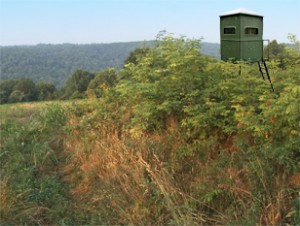
Elevated blinds at some hunting properties I visit are positioned such that it appears the only criterion used to position those blinds was being as close as possible to the plot’s entrance. Although it is possible hunters have experienced success from these blinds, I suspect they would have had more success if the blind had been located based on some simple criteria including;
- Conditions that allow the hunter to approach the stand without being smelled, heard, or seen by deer.
- The likelihood that a hunter can remain undetected by deer while in the stand under specific wind directions, etc.
- The ability of the hunter to leave the stand after the hunt without alerting deer.
These seem like simple criteria to consider when placing an elevated blind. However, locating a blind in a position that increases a hunter’s opportunity to observe and harvest mature bucks on a sustained basis can require a lot of thought. Such stands should be placed during the early to mid summer so deer can become conditioned to the new structure in their living room! Deer, especially mature deer, are often alerted by new fixtures in their territory. Fortunately deer become conditioned to stationary objects within a few weeks unless additional disturbances are associated with the object.
When scouting for a location to place a blind, it’s very important to consider the conditions that will be prevalent when the blind will be used. In many regions the predominate wind direction shifts from a southerly to a northerly direction from the summer months to mid to late fall. If a hunter’s plans include hunting the blind more in the early season compared to the late season, it may be best to place the blind for a southerly wind. Often, the best bet is to place the blind on the eastern side of the area to be hunted. Winds from the east are often rare in many areas of the whitetails’ range.
It’s just as important to consider how hunters will approach the stand without alerting deer. This often means developing a walking trail to the blind other than the road that is normally used to access the plot. This task takes a bit more work, but is well worth the effort as it can substantially increase the opportunity to observe deer from the blind.
Likewise, it’s important to consider where the deer will likely be when each hunt (morning or evening) is concluded so the hunter can leave the blind without alerting deer and conditioning them to associate the blind with danger.
If multiple blinds are to be placed, consider the time of year each will be used and the factors that will impact deer movement at that time of year. These conditions include the harvest of crops, areas that deer bed at that time of year (north slopes during summer, southern slopes during winter conditions), etc.
Each property has unique conditions that should be considered when selecting where to place elevated blinds. Take the time to consider the many aspects that impact the likelihood of observing deer on a repeated basis from an elevated blind. By doing so you can add substantial enjoyment when hunting that location! Now is prime time to do the mental and physical exercises of placing elevated blinds!
Growing Deer together,
Grant
Tough Conditions
It’s fawning season throughout most of the whitetail’s range. Current conditions have a huge impact on the survival and health of newborn fawns. Just like humans, the health of a deer while it’s a fawn is a determining factor of how much genetic potential it can express as an adult.
If the fawn is healthy and has all the resources (food, cover, water) it needs as a fawn, it has as good chance of expressing its full genetic potential as it matures. However, if the fawn is stressed by lack of quality food, fear of predation, or lack of water, its development will be hampered and it will likely not express its full genetic potential as it matures.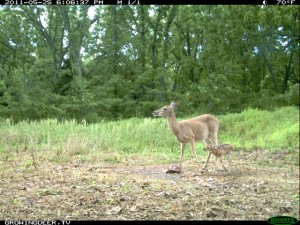
That’s why I monitor the weather, crop growth, and other factors this time of year as I plan future hunts. The current conditions this year in many areas haven’t been favorable for fawns. It’s very hot and dry in much of the southeast. It frosted last night in parts of Pennsylvania. Last week I had to wear a coat here in southwestern, Missouri and the temps are predicted to be above 90 degrees for the next seven days! West Texas, Oklahoma and other states have been experiencing a severe drought for several months.
There are always some pockets of ideal weather conditions throughout the whitetail’s range. This is one reason why huge bucks are killed in some areas for a few years and then that area returns to producing bucks with average antler size.
With all that said, I enjoy hunting properties I have a long-term relationship with the most. A mature buck is always a trophy, whether it has 140” or 180” of antler on its head. I’m a better predator on properties where I have experience. So, my chances of harvesting a mature buck are better on properties that I have a relationship with than hunting the latest “hot spot” where I don’t know the lay of the land.
When great growing conditions occur at the properties where I know the land this usually results in the best hunts for me. That obviously can’t happen every year. I set my expectations accordingly. For me the key to satisfying hunts is to hunt when and where I can with realistic expectations. I hope for good growing conditions, but learn how to be a better hunter and manager in all conditions.
Growing Deer together,
Grant
Using Color to Predict Antler Growth Potential
In a blog entry earlier this week, Using Maps To Plan Where to Hunt this Fall, I shared a source of data from the NOAA in the form of a map that predicted precipitation or the lack of for the next few weeks in the Lower 48. Precipitation levels can be correlated with forage production and quality. Too much or too little precipitation can limit plants ability to transfer nutrients from the soil to deer.
Deer require high quality nutrition on a year round basis to express their full antler growth or fawn production potential. I doubt many free-ranging, wild deer express their full potential. The stress of avoiding predators, lack of quality forage, parasites, diseases, injuries, etc., all reduce a deer’s ability to express their full potential. Of these, it’s easiest for hunters to predict the quality of forage available when planning where to hunt during the upcoming season.
This time of year many whitetail and elk hunters are applying for tags in states where they are not residents. If antler potential is a factor of where you are deciding to hunt, I encourage you to study the following map based on NOAA data.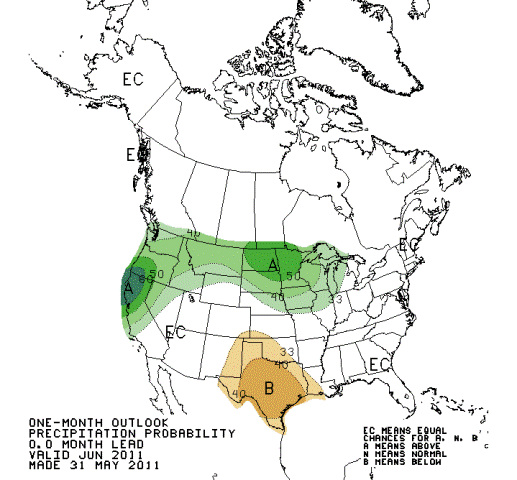
Precipitation amounts during spring green-up are critical to the antler development that year. Many forage plants (native and cultivated) are highest in digestible nutrients during the spring. If too much or not enough precipitation occurs during this time of year, the quality of forage and therefore quality of antlers can be reduced.
This is critical data to consider if you are planning an out of state hunt with the goal of harvesting a buck that has expressed a high percentage of his antler growth potential.
Based on the following map, most of west Texas, Oklahoma, and southwestern Kansas received way less than normal precipitation during the critical spring green-up period this year. Most of the Ohio River Valley and southern Missouri and Northern Arkansas received way more precipitation than normal during this same period of time. I suspect antler development will be less than average in both of these areas.
Much of the Midwestern corn belt received about the normal amount of precipitation during the same period of time. If this pattern continues throughout the summer, antler development should progress well in these areas.
Most of us have limited time and funds for hunting. By using the data from the map in this and the previous blog, those limited hunting days can be spent in areas where antler development may be the best this fall. Maps are one of the most useful scouting tools!
Growing Deer together,
Grant
Hunting Late Season Hit List Bucks
Brad and I are preparing to hunt/film this afternoon. The wind is out of the south and the temperature is seasonal to a bit cold (as it has been for a few days). Yesterday Brad checked all of our Reconyx trail cameras and reviewed the images (8,000+). Does and fawns at The Proving Grounds are beginning to frequent food plots regularly. However, images of mature bucks indicated they are still looking for a date. There were no images of mature bucks (4.5 years old or older) that indicated they were on a food/cover pattern. Given this our strategy for the next few days is to hunt where we can see the maximum number of does/fawns and hope that one of them has a hit list buck trailing behind.
We did have one two or three year old buck that was showing a pattern. He was repeatedly using a gap we created in one of our fences. We have a ground blind 10 yards away, but that buck is not on our hit list. I hope he maintains that pattern until muzzleloader or youth season so my father or one of my daughters can enjoy hunting the “fence gap.”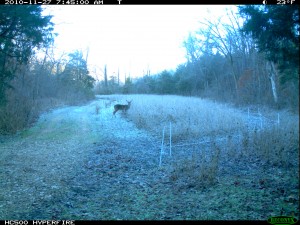
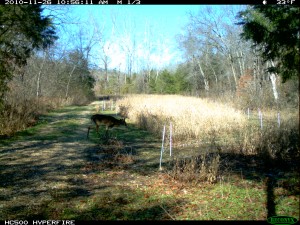
We’ve purposely have not hunted food plots much at The Proving Ground this season. Deer were simply choosing acorns. That is great if you are hunting in areas where oaks are rare like ag areas. However, when oaks dominate the landscape and the preferred food is everywhere, a huge acorn crop is a detriment to hunters. Thankfully the acorns are about all consumed and the food plots at The Proving Grounds haven’t been hunted much so the deer should be comfortable feeding there during daylight hours. We’ll start confirming if this is a good strategy this afternoon. We’ll approach and leave the stands carefully as all the work of growing the crops, hanging stands, scouting, etc., can be spoiled by carelessly alerting mature deer to our presence. Hunting mature bucks successfully usually requires a much different strategy than those I used when I was younger and simply looking to harvest any buck.
Growing Deer (and learning) together,
Grant
Hunting Food Sources
This morning was the coldest morning of the 2010-11 season to date. There is a bit of ice in the trees, and the wind chill is in the teens. These are great conditions to hunt food sources or travel routes to food sources! There was a large acorn crop this year at The Proving Grounds, so most of the treestands I hunted during the pre-rut and rut were in the woods and not overlooking or near food plots.
That means that deer at The Proving Grounds don’t currently associate the food plots with danger! This combined with the cold temperatures expected during the next week should produce some great hunting opportunities!!
Deer must consume a huge amount of calories to stay warm when the temperatures are at or below normal during the winter in the middle to higher latitudes (this is one advantage of hunting the Midwest or North compared to the South). Deer, including mature bucks, will readily feed during the daylight in quality food plots that they don’t associate with danger.
This is one reason why it is critical to limit disturbance not only at, but around food sources. Deer can easily be conditioned to feed at night if they feel threatened in such areas during the day. To reduce the chances of conditioning deer to avoid food plots during prime hunting hours I only check trail cameras, etc., during the middle of the day and when the temperatures are warmer than normal during the winter. I also am extremely conscious of wind direction and the scent cone I produce when approaching the food plot and my stand location.
In the mornings, I tend to hunt travel corridors that I suspect mature bucks will use while returning from a food source to a bedding area. This is because it is very difficult to approach fields in the morning and not spook deer since they are likely to be in or bedding very near the food source throughout the night. An exception to this seems to be on mornings when it is 10 degrees or more colder than normal. Deer tend to bed in areas of maximum thermal protection during such nights. Since they haven’t fed and used a lot of fuel to keep their furnace going all night, they will be very hungry once the temperatures increase a bit. These conditions offer an opportunity to approach a food source early in the morning without being detected for some great mid morning hunting!
The afternoons offer a great opportunity to hunt at or along travels routes to food sources. Deer will typically be bedded during the early afternoon and allow stealthy hunters a great opportunity to sneak to their stand locations.
The best tool to hunting mature bucks during cold weather is knowing where the preferred food sources are that deer don’t associate with danger and only hunt them when they can be approached without alerting deer to your presence. Cold weather, especially extended periods of cold weather, can provide fabulous opportunities to hunt mature bucks!
Growing Deer together,
Grant
Grunt Call + Z7 = Success
I harvested a nice buck yesterday at The Proving Grounds. It was a thrilling hunt that included the buck grunting/balling, and then responding to my grunts by approaching my stand and actually walking a ¾ circle around me. It might have walked all the way around my stand looking for the source of the grunt he heard except the Z7 launched.
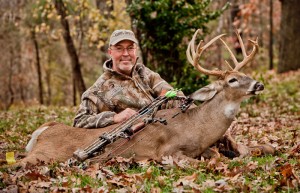 There’s much to be learned from that experience. Deer, and most wild animals, are excellent at determining the source of sound. The woods are rarely quiet as Hollywood portrays. There are small branches breaking and other common sounds that probably are not given much attention by mature bucks. Other sounds, such as metal clanking, etc., are not common and probably serve to alert deer.
There’s much to be learned from that experience. Deer, and most wild animals, are excellent at determining the source of sound. The woods are rarely quiet as Hollywood portrays. There are small branches breaking and other common sounds that probably are not given much attention by mature bucks. Other sounds, such as metal clanking, etc., are not common and probably serve to alert deer.
Bucks grunting are a normal and frequent sound in the woods this time of year, especially in areas where the deer herd has been managed to allow a substantial portion of the bucks to mature. Hence, grunt calls, as long as they are within the normal pitch and tone of real bucks’ sound, are commonly heard by deer during or just before the rut. Therefore, I use grunt calls extensively this time of year.
I prefer a call that produces a lot of volume. I will commonly look around to make sure there are no deer in view, then begin by grunting very softly. Loud grunts may alert deer that are close by and don’t expect a mature buck to be that close. If there is no response, I call again using more volume.
The second way I use a grunt call is to attempt to make deer I observe to approach closer to my stand. I simply judge how far the deer is from the stand, then call just loud enough so they can hear the call. I typically call softly and increase the volume until the buck acknowledges the call.
Don’t be scared to use a grunt call. This week throughout most of the whitetails’ range is a great time to use a grunt call. I use a homemade call that a friend gave me. It can produce a lot of volume and the tone is medium to deep. Grunt calls are one of my favorite tools to harvest mature bucks.
Growing Deer together,
Grant





















